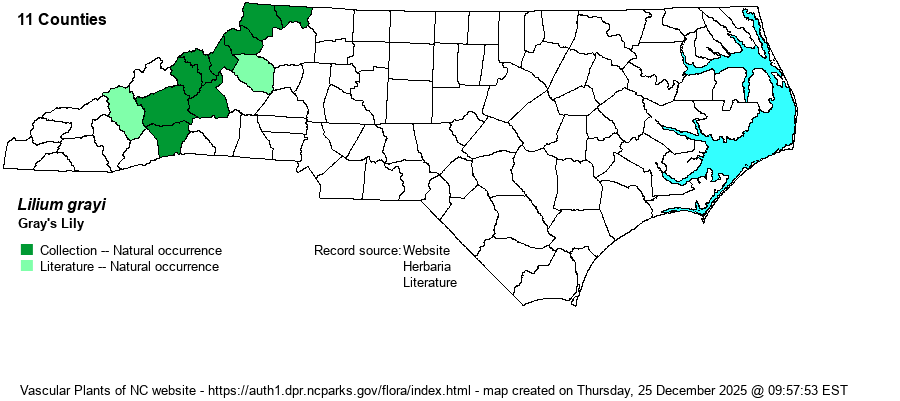| Author | S. Watson | |
| Distribution | Present throughout the northern half of the Mountains, and then sparingly south to the central Mountains (Haywood, Buncombe, and Henderson counties).
This is a Southern Appalachian endemic species, found only in three states. It ranges north just to west-central VA, and then south to western NC and extreme eastern TN. | |
| Abundance | Strongly declining in recent years owing to a fungal disease. Prior to perhaps 2015, it was uncommon to infrequent, but common at a few sites, in the northern counties, but now mostly quite uncommon. Generally rare in the central Mountains. This is a State Threatened species. The Global Rank was moved from G3 to an alarming G1G2 by NatureServe within the last year or two. | |
| Habitat | This lily favors cool microclimates at the higher elevations, mainly over 4,000 feet. It has a fairly wide array of habitats, though most tend to have some moisture. It grows in moist grassy balds, high elevation forests along seepages, bogs, wet meadows, and other moist forests; some can be below 3000 feet in elevation. It is best known from grassy balds such as at Roan Mountain, but it does grow well in shaded areas where there is seepage, such as at Grandfather Mountain. | |
| Phenology | Blooms in June and July, and fruits in August and September. | |
| Identification | This is a beautiful wildflower, as are all Lilium species, and it is likely the highlight of a summer walk across the grass balds at Roan Mountain. The plant grows 2-4 feet tall, with each plant holding an average of 3-8 bright red to deep orange-red flowers. The flowers are in a horizontal or diagonally drooping position, and the 6 tepals are about 2 inches long, only modestly spreading. The leaves are arranged in 4-8 whorls along the stem, with about 4-8 leaves in each whorl. The leaves are not necessary for identification when the flowers are available, but non-flowering plants must be carefully separated from L. superbum, which is a relatively common species of moist montane habitats. L. grayi typically has leaves about 4-6x as long as wide, whereas L. superbum usually has more leaves in a whorl and they average 6-8x as long as wide. L. michauxii has leaves that are somewhat thick, and they are always widest well beyond the midpoint. These two lilies have completely different flowers, both which have the stamens extending well beyond the tepals, which are so strongly recurved that they practically touch behind the flower. Normally, L. grayi grows in elevations above those of the very rare L. canadense, and the latter species has flowers than dangle downward and with the tepals strongly recurved. | |
| Taxonomic Comments | None
| |
| Other Common Name(s) | Roan Lily, Bell Lily | |
| State Rank | S1S2 | |
| Global Rank | G1G2 | |
| State Status | T | |
| US Status | | |
| USACE-agcp | | |
| USACE-emp | FACU link |

